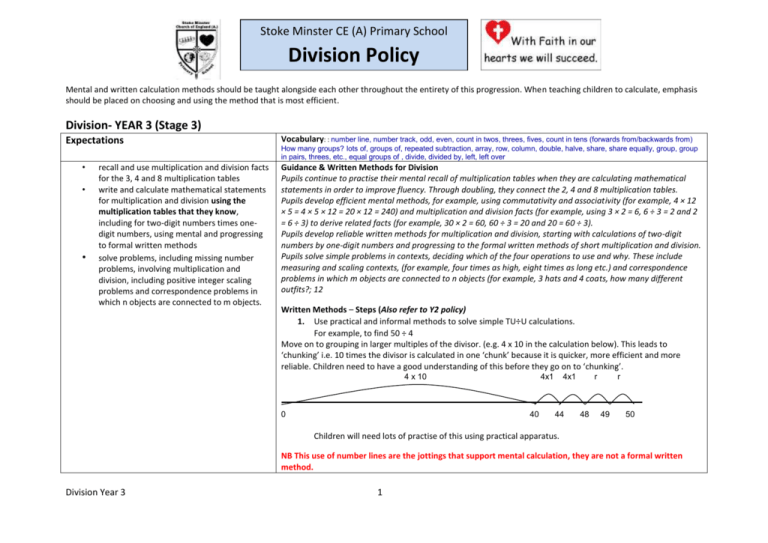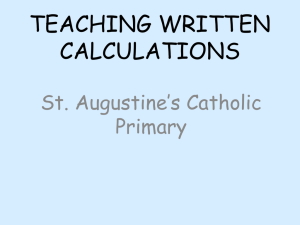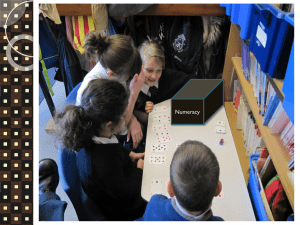Y3 Division CP - Stoke Minster CE School
advertisement

Stoke Minster CE (A) Primary School Division Policy Mental and written calculation methods should be taught alongside each other throughout the entirety of this progression. When teaching children to calculate, emphasis should be placed on choosing and using the method that is most efficient. Division- YEAR 3 (Stage 3) Expectations • • • recall and use multiplication and division facts for the 3, 4 and 8 multiplication tables write and calculate mathematical statements for multiplication and division using the multiplication tables that they know, including for two-digit numbers times onedigit numbers, using mental and progressing to formal written methods solve problems, including missing number problems, involving multiplication and division, including positive integer scaling problems and correspondence problems in which n objects are connected to m objects. Vocabulary: : number line, number track, odd, even, count in twos, threes, fives, count in tens (forwards from/backwards from) How many groups? lots of, groups of, repeated subtraction, array, row, column, double, halve, share, share equally, group, group in pairs, threes, etc., equal groups of , divide, divided by, left, left over Guidance & Written Methods for Division Pupils continue to practise their mental recall of multiplication tables when they are calculating mathematical statements in order to improve fluency. Through doubling, they connect the 2, 4 and 8 multiplication tables. Pupils develop efficient mental methods, for example, using commutativity and associativity (for example, 4 × 12 × 5 = 4 × 5 × 12 = 20 × 12 = 240) and multiplication and division facts (for example, using 3 × 2 = 6, 6 ÷ 3 = 2 and 2 = 6 ÷ 3) to derive related facts (for example, 30 × 2 = 60, 60 ÷ 3 = 20 and 20 = 60 ÷ 3). Pupils develop reliable written methods for multiplication and division, starting with calculations of two-digit numbers by one-digit numbers and progressing to the formal written methods of short multiplication and division. Pupils solve simple problems in contexts, deciding which of the four operations to use and why. These include measuring and scaling contexts, (for example, four times as high, eight times as long etc.) and correspondence problems in which m objects are connected to n objects (for example, 3 hats and 4 coats, how many different outfits?; 12 Written Methods – Steps (Also refer to Y2 policy) 1. Use practical and informal methods to solve simple TU÷U calculations. For example, to find 50 ÷ 4 Move on to grouping in larger multiples of the divisor. (e.g. 4 x 10 in the calculation below). This leads to ‘chunking’ i.e. 10 times the divisor is calculated in one ‘chunk’ because it is quicker, more efficient and more reliable. Children need to have a good understanding of this before they go on to ‘chunking’. 4 x 10 0 4x1 40 4x1 44 r 48 r 49 50 Children will need lots of practise of this using practical apparatus. NB This use of number lines are the jottings that support mental calculation, they are not a formal written method. Division Year 3 1 Year 3 division continued . . . 2. Special names for numbers in division Start grouping on the number line in larger groups that are not always multiples of 10 as this is what children already know, (Children should be taught to approximate first to gain a sensible idea of what the answer must be). 6 x 10 dividend ÷ divisor = quotient 6x6 0 Related calculations and estimates To utilize further methods, children need to a) know their multiplication facts and how to use a multiplication grid for those have not committed to memory. b) be able to identify and use related calculations and place value effectively e.g. for 126 ÷ 3 they must be able to calculate 120 ÷ 3. They need to recognise the ‘root’ calculation 12 ÷ 3 = 4 and understand that as 120 is ten times greater than 12 the quotient will also be ten times greater. 120 ÷ 3 = 40 60 96 97 98 98 ÷ 6 = 16 r 2 Then transfer this skill to set out as long division by chunking. 3. a) Set out on a number line and transfer to long division by chunking. b) Work out by long division and use grouping on a number line to check answer. c) Just use long division by chunking as shown below. Chunking – without remainders 96 ÷ 6 = 16 16 6 96 - 60 (6 X 10) 36 - 36 (6 X 6) 0 4. Chunking – with remainders 98 ÷ 6 = 16 r 2 16 6 98 - 60 (6 X 10) 38 - 36 (6 X 6) 2 a) Set out as chunking and transfer to short method. b) Work out by short method and use chunking to check answer. c) Just use short method as shown below. Short division – without remainders Short division – with remainders 96 ÷ 6 = 16 98 ÷ 6 = 16 r 2 6 Division Year 3 r r 1 6 9³6 6 2 1 6r2 9³8







